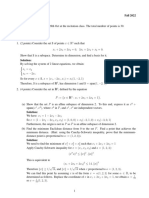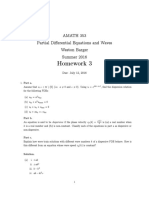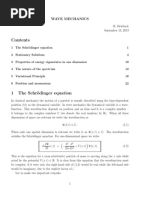PG 0005
Uploaded by
Boldie LutwigCopyright:
Available Formats
PG 0005
Uploaded by
Boldie LutwigOriginal Title
Copyright
Available Formats
Share this document
Did you find this document useful?
Is this content inappropriate?
Copyright:
Available Formats
PG 0005
Uploaded by
Boldie LutwigCopyright:
Available Formats
Kevin Zhou Physics Olympiad Handouts
The stopping time t can be found by canceling out the length dimension. If t ∝ (b/m)α v β ,
then:
α(1 − n) + β = 0 α(−2 + n) − β = 1
Solving yields
mv 1−n
α = −1 β = 1 − n, t∝ .
b
The distance x traveled has dimensions of vt, so
mv 2−n
x∝ .
b
(b) The results don’t seem to make sense. At n = 1, it appears that the time it takes to stop
no longer depends on v, which doesn’t seem correct since the stopping time should always
increase with velocity. And for n > 1, the stopping time decreases with velocity, which is even
worse. Similar issues happen for the stopping distance for n ≥ 2.
The resolution is that in these cases, the stopping time/distance are actually infinite, as you
can check explicitly. In other words, dimensional analysis worked, but the hidden dimensionless
prefactor was infinity.
Idea 2
Dimensional analysis applies everywhere. The argument of any function that is not a mono-
mial, such as sin x, must have no dimensions. The derivative d/dx has the opposite dimensions
to x, and the dx in an integral has the same dimensions as x.
Example 3
We are given the integral Z ∞ √
2
e−x dx = π.
−∞
Find the value of the integral Z ∞
2
e−ax dx.
−∞
Solution
In the first equation, x must be dimensionless, so both sides are dimensionless. The second
equation would also be consistent if both x and a were dimensionless, but we can do better.
Suppose we arbitrarily assign x dimensions of length, [x] = m. Then to make the argument
of the exponential dimensionless, a must have dimensions [a] = m−2 . The dimensions of the
left-hand side are [dx] = m. In order to make the dimensions work out on the right-hand
side, we must have Z ∞
2 1
e−ax dx ∝ √ .
−∞ a
To find the value of the constant, treat x and a as dimensionless again. Then we know the
You might also like
- Estimation For G+2 Residential Building - R1No ratings yetEstimation For G+2 Residential Building - R113 pages
- Problem Solving I: Mathematical Techniques: 1 Dimensional AnalysisNo ratings yetProblem Solving I: Mathematical Techniques: 1 Dimensional Analysis27 pages
- The Infinite Square Well: PHY3011 Wells and Barriers Page 1 of 17No ratings yetThe Infinite Square Well: PHY3011 Wells and Barriers Page 1 of 1717 pages
- 1 Review of Key Concepts From Previous Lectures: Lecture Notes - Amber Habib - December 1No ratings yet1 Review of Key Concepts From Previous Lectures: Lecture Notes - Amber Habib - December 14 pages
- 1 Estimating Uncertainties and Propagation of Errors: Physics 326, Final ExamNo ratings yet1 Estimating Uncertainties and Propagation of Errors: Physics 326, Final Exam4 pages
- Identifying Primes in Polynomial Time: The AKS Algorithm: Andrew PutmanNo ratings yetIdentifying Primes in Polynomial Time: The AKS Algorithm: Andrew Putman11 pages
- Homework in Mathematical Hydrodynamics: BJ Orn GustafssonNo ratings yetHomework in Mathematical Hydrodynamics: BJ Orn Gustafsson8 pages
- Lecture # 23: Subject No. PH11003 (Physics of Waves) Duration: 2 HRNo ratings yetLecture # 23: Subject No. PH11003 (Physics of Waves) Duration: 2 HR14 pages
- The ,,math Stars" Contest 6-7 December 2008: 1. Prove That, For Every Positive Integer M, The EquationNo ratings yetThe ,,math Stars" Contest 6-7 December 2008: 1. Prove That, For Every Positive Integer M, The Equation9 pages
- Solutions To The 71st William Lowell Putnam Mathematical Competition Saturday, December 4, 2010No ratings yetSolutions To The 71st William Lowell Putnam Mathematical Competition Saturday, December 4, 20105 pages
- Lecture 13: Delta Function Potential, Node Theorem, and Simple Harmonic OscillatorNo ratings yetLecture 13: Delta Function Potential, Node Theorem, and Simple Harmonic Oscillator13 pages
- Features Integration of Differential Binomial: DX BX A X P N MNo ratings yetFeatures Integration of Differential Binomial: DX BX A X P N M4 pages
- Chap7 Schrodinger Equation 1D Notes s12No ratings yetChap7 Schrodinger Equation 1D Notes s1214 pages
- Stability and Convergence of The Wavelet-Galerkin ...No ratings yetStability and Convergence of The Wavelet-Galerkin ...19 pages
- Defining Exponential Functions Via LimitsNo ratings yetDefining Exponential Functions Via Limits7 pages
- Momentum - Presentation 2013 07 29 BLV 1 Slide Per PageNo ratings yetMomentum - Presentation 2013 07 29 BLV 1 Slide Per Page95 pages
- Circular Motion Multiple Choice Homework: PSI PhysicsNo ratings yetCircular Motion Multiple Choice Homework: PSI Physics7 pages
- Uniform Circular Motion: PSI AP Physics 1No ratings yetUniform Circular Motion: PSI AP Physics 16 pages
- Aapt United States Physics Team: 216 Year 2018No ratings yetAapt United States Physics Team: 216 Year 201823 pages
- 25+ Contoh Soal Bahasa Inggris Kelas 8 SMP MTs Semester GanjilNo ratings yet25+ Contoh Soal Bahasa Inggris Kelas 8 SMP MTs Semester Ganjil6 pages
- Knowledge of People On The Importance of Liquid Waste DisposalNo ratings yetKnowledge of People On The Importance of Liquid Waste Disposal71 pages
- Geotechnical Engineering-Ii: BSC Civil Engineering - 5 SemesterNo ratings yetGeotechnical Engineering-Ii: BSC Civil Engineering - 5 Semester19 pages
- Michael Jackson: Death by Drugs Project Created By: Elizabeth Lux Period 4/5No ratings yetMichael Jackson: Death by Drugs Project Created By: Elizabeth Lux Period 4/57 pages
- Do Green Innovation and Green Competitive Advantage Mediate The Effect of Green Marketing Orientation On SMEs Green Marketing PerformanceNo ratings yetDo Green Innovation and Green Competitive Advantage Mediate The Effect of Green Marketing Orientation On SMEs Green Marketing Performance20 pages
- CMIT-796-PIP-15.69-00-0008 - 0 3D Model Review ProcedureNo ratings yetCMIT-796-PIP-15.69-00-0008 - 0 3D Model Review Procedure10 pages
- Society For Research in Child Development, Wiley Child DevelopmentNo ratings yetSociety For Research in Child Development, Wiley Child Development9 pages
- Dokumen - Pub - Statistics-For-Bus94160-1337516716-9781337516716 1008No ratings yetDokumen - Pub - Statistics-For-Bus94160-1337516716-9781337516716 10081 page
- International Aspects of The History of Earthquake EngineeringNo ratings yetInternational Aspects of The History of Earthquake Engineering136 pages
- Prospectus For Selection of Trainee Electro Technical Officer (Eto) June, 2018 BatchNo ratings yetProspectus For Selection of Trainee Electro Technical Officer (Eto) June, 2018 Batch11 pages





































































































